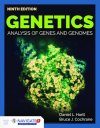Textbook
By: Daniel L Hartl(Author), Bruce J Cochrane(Author)
829 pages, colour photos, colour illustrations, tables
![Genetics: Analysis of Genes and Genomes Genetics: Analysis of Genes and Genomes]()
Click to have a closer look
About this book
Contents
Customer reviews
Biography
Related titles
About this book
Genetics: Analysis of Genes and Genomes is a resource uniquely suited for learning and applying genetics to our world. Its DNA first presentation frames the discussion of genetics in modern terms, which provides the user the context to then understand its Mendelian history. Genetics continues to treat transmission genetics, molecular genetics, and evolutionary genetics as fully integrated subjects and provides students with an unprecedented understanding of the basic process of gene transmission, mutation, expression, and regulation. A new unit structure with self-contained chapters provides the flexibility to fit any course design, whether it be Mendel-early, Chromosome-early, or a Genome-first approach. The dynamism of genetics is also perfectly captured, as coverage of technological advances is woven together with ethical controversies.
Problem-solving is a core element to this experimental discipline, and the ninth edition of Genetics: Analysis of Genes and Genomes is unparalleled in the tools it provides to unlock this fascinating subject. This rich resource allows students copious opportunities to practice and learn by using the clearly-presented mathematical concepts and exercises and chapter problems that encourage students to analyze and apply new skills.
New to this edition:
- New sections discuss Genome-Wide Association Scans, misconceptions about heritability, Illumina sequencing, Cancer Genomics, Wolbachia in arthropod species, molecular signals of selection, Regulatory RNAs in Development, and more.
- New Cutting-Edge boxes highlight recent research and developments in the field, such as the use of CRISPR-Cas9 for gene repair in muscular dystrophy
- New interior design featuring over 225 new and revised illustrations with descriptions that clarify difficult concepts, such as Chi-square Analysis, Pedigree Analysis, Epistasis, Molecular Biology Techniques, and Mutations on Gene Expression
Contents
Unit I Defining and Working with GENES
Chapter 1 Genes, Genomes and Genetic Analysis
Chapter 2 DNA Structure and Genetic Variation
Unit II Transmission Genetics
Chapter 3 Transmission Genetics: The Principle of Segregation
Chapter 4 The Chromosomal Basis of Inheritance
Chapter 5 Genetic Linkage and Chromosome Mapping
Chapter 6 Human Karyotypes and Chromosome Behavior
Chapter 7 The Genetics of Complex Characters
Chapter 8 Genetics of the Bacteria and their Viruses
Unit III Organization and Replication of Chromosomes and DNA
Chapter 9 Molecular Organization of Chromosomes and Genomes
Chapter 10 DNA Replication and Sequencing
Chapter 11 Mutation, Repair and Recombination
Unit IV Gene Expression
Chapter 12 Molecular Biology of Gene Expression
Chapter 13 Molecular Mechanisms of Gene Regulation
Chapter 14 Manipulating Genes and Genomes
Chapter 15 Genetic Control of Development
Chapter 16 The Genetics of Cancer
Unit V Variation
Chapter 17 Mitochondrial DNA and Extranuclear Inheritance
Chapter 18 Genetics of Populations
Chapter 19 Molecular and Human Evolutionary Genetics
Customer Reviews
Biography
Daniel L. Hartl is Higgins Professor of Biology in the Department of Organismic and Evolutionary Biology at Harvard University. He has authored or coauthored more than 300 scientific articles and 20 books in genetics, genomics, molecular evolution, and population genetics. He has served as president of the Genetics Society of America and the Society for Molecular Biology and Evolution. He has also served as Chairman of his department at Harvard. He is was elected to the National Academy of Sciences and the American Academy of Arts and Sciences. He received his PhD from the University of Wisconsin. His research interests include evolutionary genomics, molecular evolution and population genetics.
Textbook
By: Daniel L Hartl(Author), Bruce J Cochrane(Author)
829 pages, colour photos, colour illustrations, tables



























